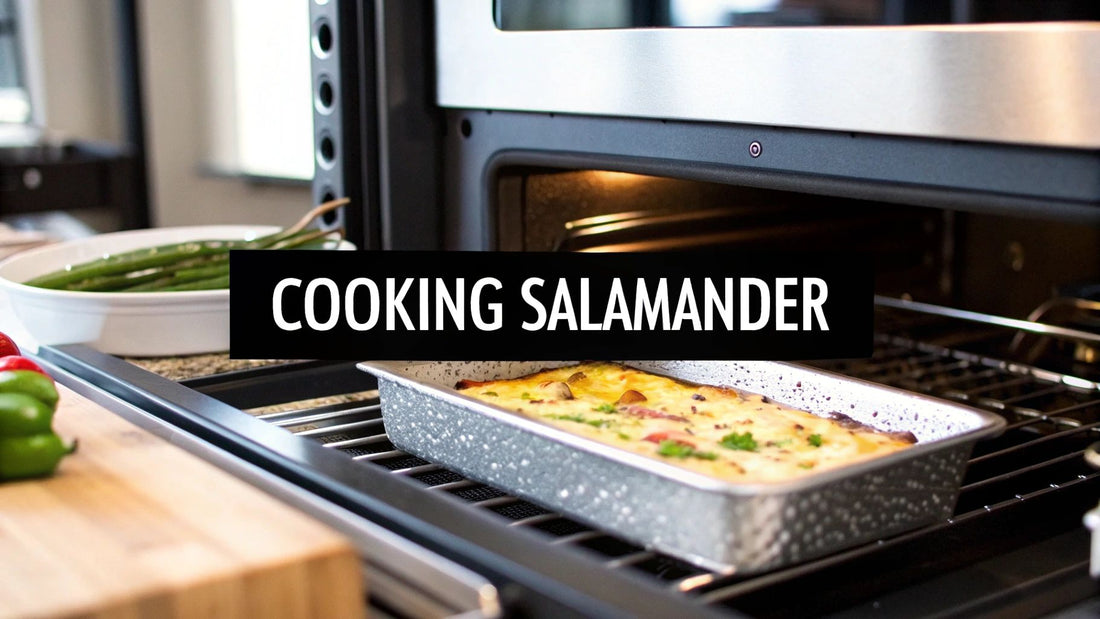
What Is a Salamander in Cooking & Why Chefs Use It
Share
Heard the word "salamander" in a kitchen and pictured a little amphibian scurrying around? It’s a common mix-up, but in the culinary world, a salamander is a powerhouse of a broiler, not a lizard. Think of it as a specialized, high-heat tool designed for one crucial job: finishing dishes with intense, focused heat from above.
What Exactly Is a Salamander in a Kitchen?
Imagine an upside-down grill, and you're pretty close. Instead of cooking food with heat rising from below, a salamander blasts radiant heat downwards. You'll typically find them mounted on a wall or sitting over a range, ready to apply that final, transformative touch to a dish right before it heads out to a customer.
This isn't just a random name, either. The term has some cool history behind it. When this appliance first appeared in the 19th century, it was named after the mythological salamander, a creature that was fabled to be able to live in fire. It’s a fitting name for a tool that professional chefs quickly embraced to perfect dishes needing that final, intense blast of heat. You can dig a little deeper into the dual meanings of the word salamander on Wikipedia.
To clear up any lingering confusion between the kitchen tool and the creature, let's break it down.
Salamander Tool vs Animal at a Glance
| Attribute | Salamander (Cooking Tool) | Salamander (Amphibian) |
|---|---|---|
| Primary Role | High-heat overhead broiler | Slender, long-tailed amphibian |
| Habitat | Professional kitchens, above ranges | Damp forests, near streams |
| Heat Source | Gas or electric elements | None; cold-blooded |
| Main Diet | Food needing browning/melting | Insects, worms, and small prey |
| Key Feature | Intense radiant heat from above | Smooth skin, regenerative abilities |
While both are fascinating in their own right, only one will give you that perfect, bubbly cheese on your French onion soup.
Primary Uses in Professional Kitchens
So, what do chefs actually do with this thing? A salamander is the master of the finishing touch. It's not for cooking a steak from raw, but for a handful of key techniques that take a dish from good to great:
- Caramelizing: It’s the secret to that perfectly glassy, crackable sugar crust on a crème brûlée.
- Browning: It gives gratins, casseroles, and pasta bakes that beautiful, irresistible golden-brown top.
- Melting: It's how you get cheese on French onion soup or nachos to melt perfectly without turning everything underneath to mush.
- Toasting: It's fantastic for quickly toasting bread for bruschetta or warming up sandwiches.
While a salamander is the finishing specialist, other equipment handles the heavy lifting. For getting those classic grill marks on steaks, burgers, and vegetables, professional kitchens rely on different tools. We carry a wide selection of commercial charbroilers, including high-performance infrared, gas, and electric charbroilers, which are built for the direct, high-heat grilling a salamander isn't designed for. Used together, these two pieces of equipment create an unstoppable combo for any restaurant.
Unpacking the Name and Mythological Origins
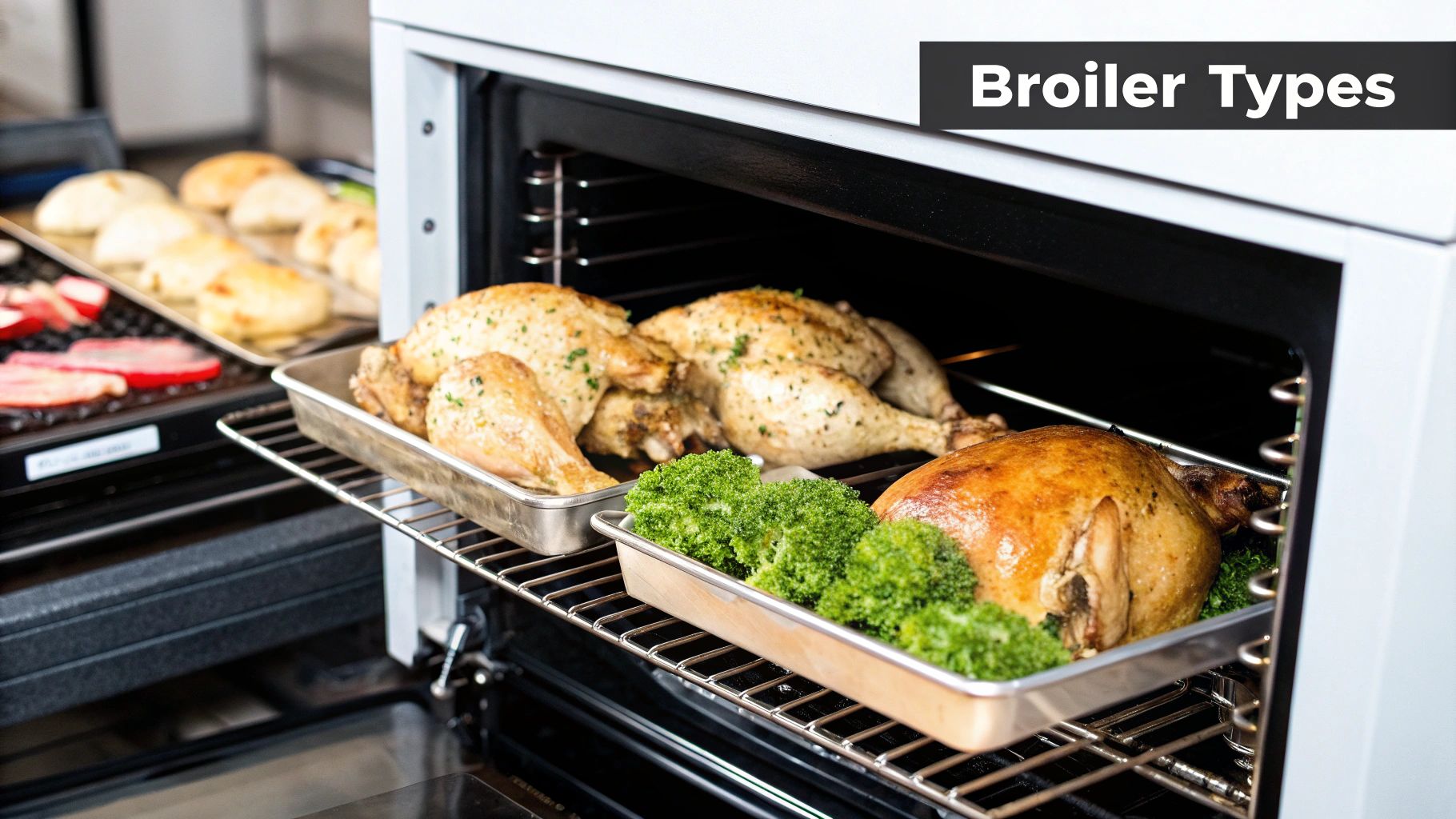
Ever wondered why a piece of kitchen equipment shares its name with a lizard? The story behind the "salamander" broiler is actually pretty cool, and it goes way back to ancient myths. For centuries, folklore told tales of a legendary salamander—a creature born from fire that could walk through flames completely unharmed. Even ancient thinkers like Aristotle and Pliny the Elder wrote about these mythical, fire-proof beings.
It’s a powerful image, and you can see why it was the perfect name for this specific cooking tool. A salamander broiler blasts food with incredibly intense, top-down heat. It’s a wall of fire, really. Naming it after a creature believed to command the flames was a brilliant way to capture its core function: finishing dishes with a quick, fiery blast.
A Tale of Two Salamanders
Now, here's where things can get a little confusing. While the kitchen tool’s name is purely symbolic, there's another, more literal answer when we talk about salamanders in cooking. In some parts of the world, the actual amphibian is considered a delicacy, a practice that's now wrapped in serious ecological and ethical trouble.
The most famous example is the Chinese giant salamander. As the planet's largest amphibian, it was historically a high-end luxury food in China. This demand, however, has driven the wild species to the edge of extinction. Surveys from 2020–2021 found that over 200,000 giant salamanders were being farmed to meet demand, a practice that only complicates efforts to save their Critically Endangered wild relatives.
So, let's be clear: when a chef yells for a "salamander" in a professional kitchen, they are always talking about the high-heat broiler. It's a specialist tool designed for those crucial finishing touches.
Getting your equipment straight is key. A salamander provides intense overhead radiant heat for browning and melting. But if you need to put grill marks on a steak, you need a different machine entirely. To see how these tools compare, check out our guide that answers the question, what is a charbroiler, and learn how it creates flavor with direct-contact heat.
How a Salamander Broiler Actually Works
So, what exactly is a salamander doing up there on the line? Think of it less like a traditional oven that bakes with circulating hot air, and more like a focused, high-intensity heat lamp designed for one thing: speed. It’s all about blasting the surface of food with powerful, top-down radiant heat to finish a dish in seconds, not minutes.
The magic comes from heating elements positioned directly over the food. Whether they’re powered by gas, electricity, or infrared, these elements get incredibly hot, incredibly fast. This intense energy radiates straight down, hitting the food on the rack below and kicking off the Maillard reaction (that delicious browning on proteins) and caramelization.
A chef's control is what makes this tool so versatile. The cooking rack is adjustable, letting you dial in the heat intensity with precision. Need to gently melt cheese over some nachos? Raise the rack for a softer heat. Want to put a hard, glassy sear on a crème brûlée? Lower the rack right into the blast zone for a scorching finish.
Heat Source Technologies
The engine driving a salamander broiler comes in three main flavors, and the one you choose can make a big difference in your kitchen's workflow. Each has its own strengths.
- Gas Salamanders: These are the classic workhorses. Chefs often love them for their raw power and rapid preheating, making them a perfect fit for high-volume kitchens that are constantly pushing out orders.
- Electric Salamanders: If precision is the name of the game, electric is your player. They're known for their exceptionally even heat and fine-tuned temperature control, which is ideal for more delicate finishing jobs.
- Infrared Salamanders: These are the speed demons. Infrared broilers use special ceramic or metal plates to generate intense, searing heat almost instantly. This drastically cuts down on both cooking times and energy bills.
The image below really puts the salamander's power into perspective, showing just how much faster it works compared to a standard broiler.
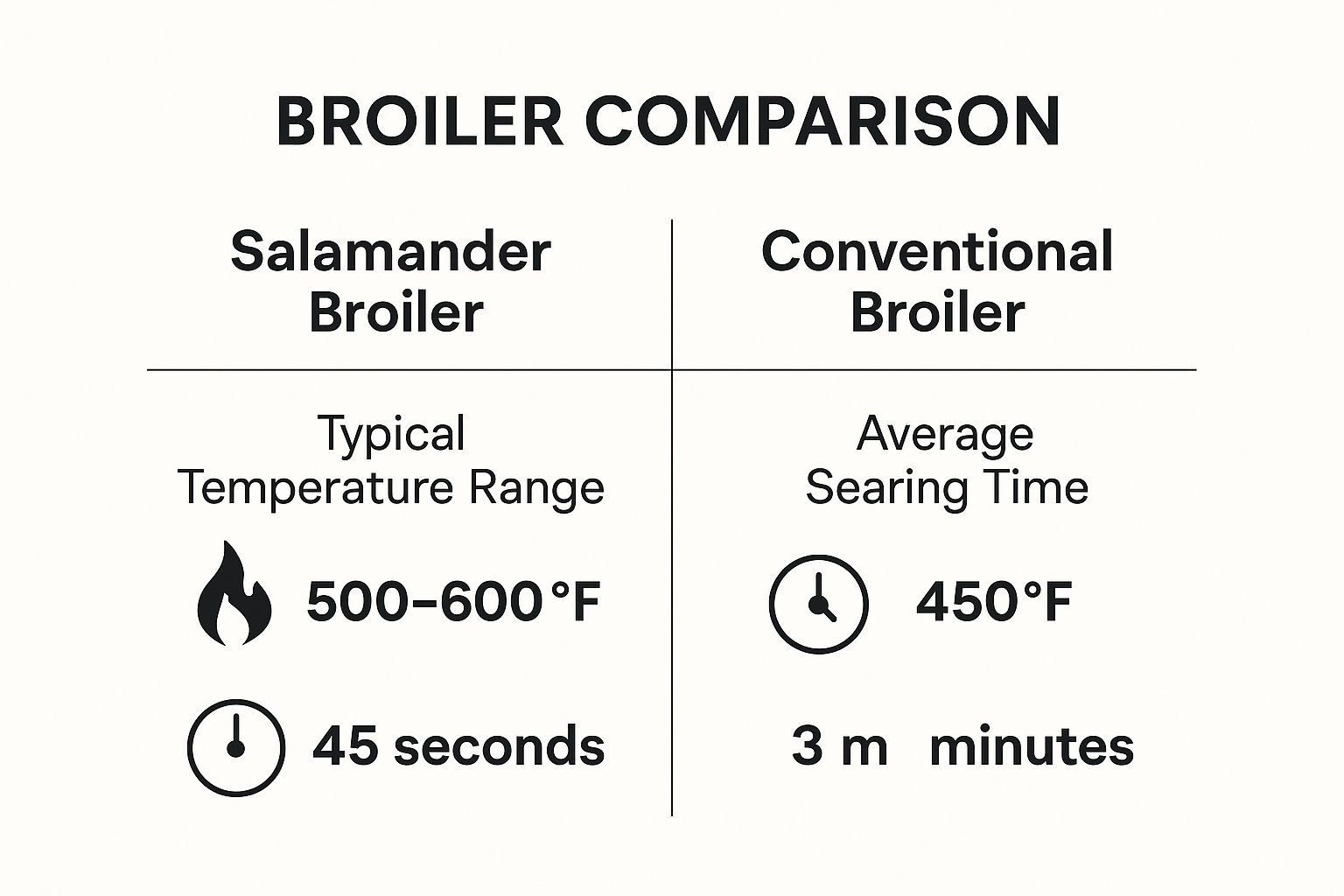
As you can see, that blistering heat makes a world of difference, searing food in a fraction of the time.
To help you decide which type is right for your kitchen, here’s a quick breakdown of how the different heat sources stack up against each other.
Salamander Heat Source Comparison
| Heat Source | Heating Speed | Temperature Control | Best For |
|---|---|---|---|
| Gas | Very Fast | Good | High-volume kitchens, steakhouses |
| Electric | Moderate | Excellent | Delicate finishing, precise melting |
| Infrared | Instantaneous | Very Good | Speed-focused kitchens, energy savings |
Ultimately, the right heat source depends on your menu and volume. An all-day diner might prefer the reliability of gas, while a fine-dining spot could benefit from the precision of electric.
This intense focus on high-heat finishing makes the salamander a true specialist. It’s the king of browning and melting, but it's not designed for other tasks. If you're looking for equipment to handle different high-heat jobs, like frying, you'll need another tool in your arsenal. You can check out our guide to the top commercial deep fryers to see what those workhorses can do.
At the end of the day, a salamander’s job is to deliver that final, perfect touch. Its ability to provide intense, controlled overhead heat is what makes it one of the most valuable—and indispensable—pieces of equipment in any fast-paced kitchen.
Salamander Broilers Versus Other Kitchen Equipment
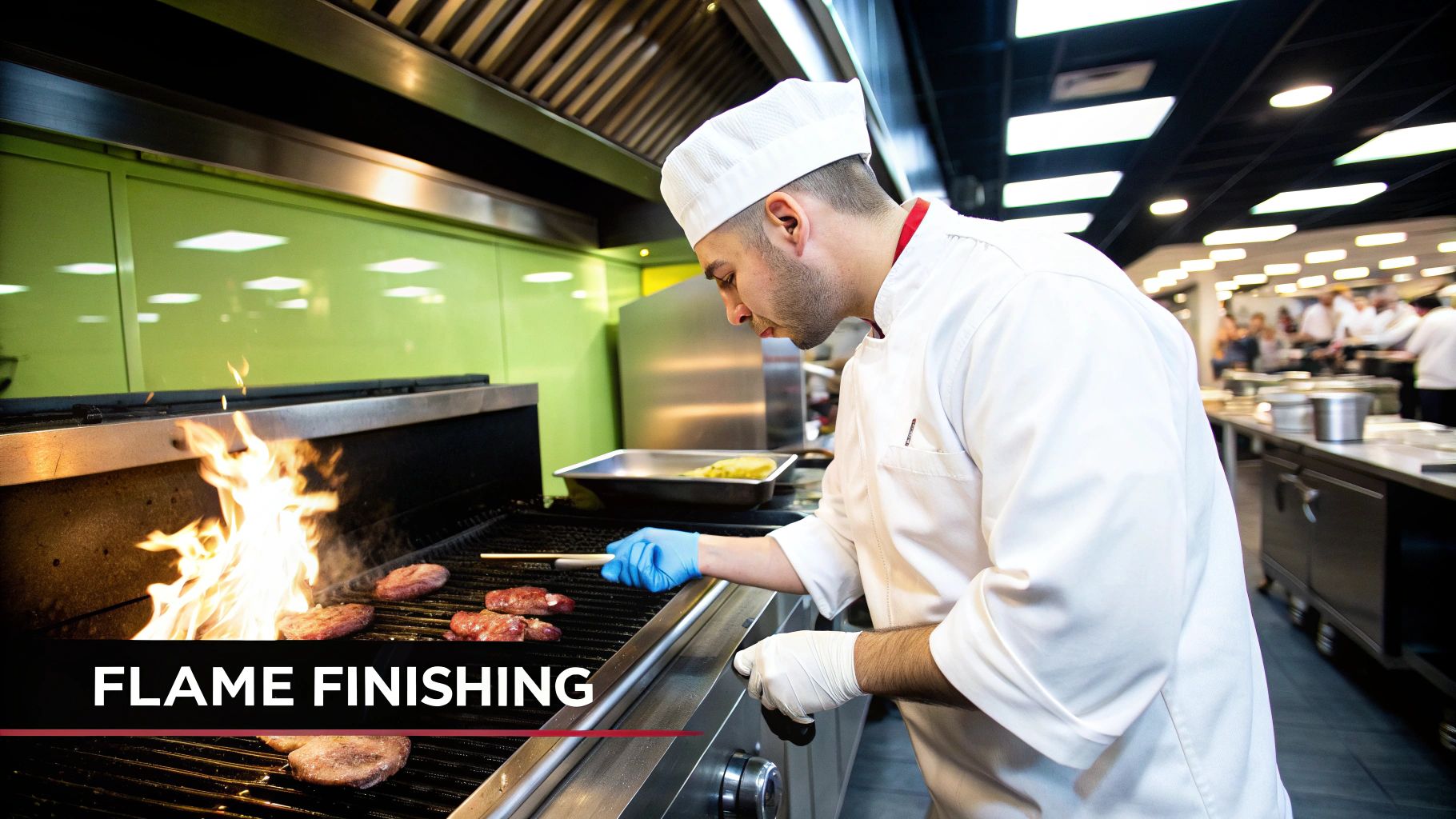
To really get a feel for what a cooking salamander does, it helps to see how it stacks up against the other gear on your line. While plenty of equipment gets hot, the salamander is a true specialist. It’s not trying to be a jack-of-all-trades; its power comes from its unique, focused, top-down radiant heat.
The first thing people compare it to is the broiler in a regular oven. While they both use heat from above, a salamander is in a completely different league. It gets screaming hot in seconds, capable of browning a gratin or caramelizing sugar on a crème brûlée in less than a minute. An oven broiler, on the other hand, can take several minutes just to heat up before it even starts cooking.
Then there’s the cheesemelter, which can look almost identical. But don't be fooled—it's built for a different job. A cheesemelter uses gentle, low-intensity heat, perfect for melting cheese on nachos or just keeping a finished plate warm. A salamander uses aggressive, high-intensity heat that’s designed to broil, brown, and sear with serious power.
The Role of a Commercial Charbroiler
This is where the distinction becomes critical for any serious kitchen. A salamander is all about the finish, not the main event. When you need to grill steaks, burgers, or vegetables to get those classic sear marks and that smoky flavor, you need a different beast entirely: the commercial charbroiler.
A charbroiler cooks with intense heat from below, directly searing food on hot grates. It’s built for heavy-duty grilling, a task the overhead salamander simply isn't designed for. A well-equipped kitchen uses both—one for grilling, one for finishing.
For all your heavy-duty grilling needs, we offer a wide selection of commercial charbroilers, including high-performance infrared, gas, and electric charbroilers. Whether you need the raw power of gas for a busy steakhouse or the precision of infrared for delicate fish, our collection has the right tool to complement your salamander and complete your cooking line.
Choosing the Right Salamander for Your Restaurant
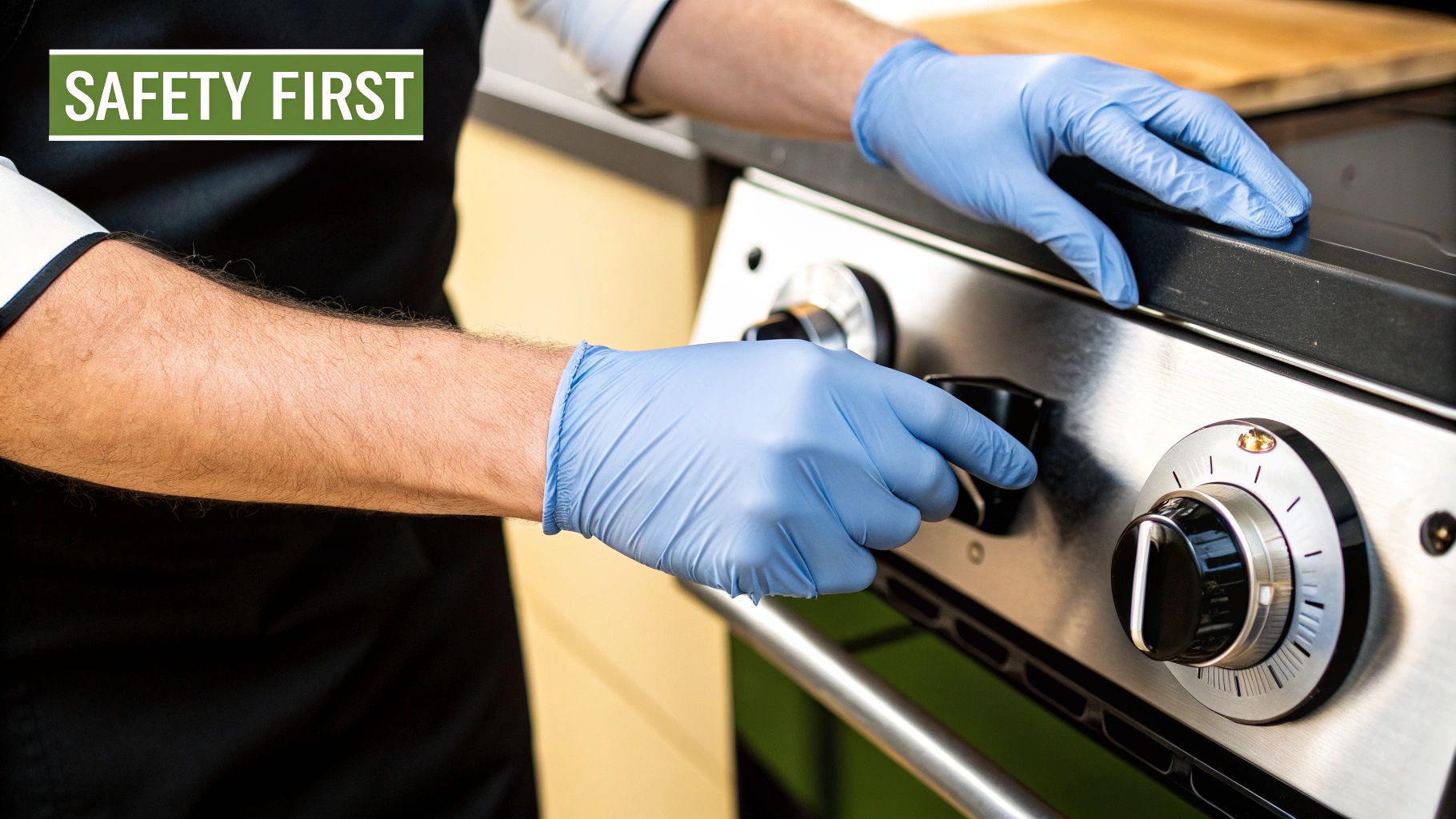
Investing in a salamander is a smart play, but picking the right one means getting honest about your kitchen's real-world needs. Before you even think about hitting "buy," take a hard look at your menu.
Are you browning dozens of French onion soups an hour, or just torching a few crème brûlées for dessert service? High-volume kitchens need a beast that heats up fast and keeps up with the rush. A smaller café, on the other hand, might get by just fine with a more compact, energy-sipping model.
Next up, space. We all know kitchen real estate is gold. The good news is that salamanders are born to fit into tight spots. Wall-mounted units are fantastic space-savers, while range-mounted models sit right over your cooking suite, creating a killer integrated workstation. Countertop versions give you flexibility, but they'll eat up that precious prep area.
Key Features to Look For
When you're comparing models, a few features can make a world of difference in the daily grind. Keep an eye out for these game-changers:
- Durable stainless steel construction: This isn't just for looks. It needs to stand up to the chaos of a commercial kitchen and be a breeze to sanitize.
- A removable drip tray: This is non-negotiable. It makes cleanup so much faster and stops grease from building up, which is a massive safety win.
- Adjustable rack positions: This feature is your key to precision. It gives you total control over the heat intensity, letting you go from gently melting cheese to blasting a dish with a powerful sear just by changing the rack height.
A salamander is the king of overhead finishing, but it's not built for grilling. If you need those classic sear marks on steaks, burgers, or veggies, you’re looking for a different tool altogether. That's where a high-quality charbroiler enters the picture.
To complete your cooking lineup, we offer a wide selection of commercial charbroilers for your restaurant, including powerful infrared, gas, and electric char broilers. Each is designed to handle the heavy-duty grilling a salamander isn't built for, giving you a perfect combination of equipment.
Choosing the right equipment is all about building a complete cooking system. A salamander masters the finishing touch, but other tools own different methods. For jobs that need a big, flat, hot surface—think pancakes, smash burgers, or breakfast service—check out our guide to commercial griddles to round out your kitchen’s arsenal. Making smart, informed choices on all your gear is what keeps a kitchen running at peak efficiency.
Frequently Asked Questions About Salamander Broilers
https://www.youtube.com/embed/5NiQAqdaqFo
When you’re thinking about bringing a salamander broiler into your kitchen, a few questions always pop up. It's smart to have the answers sorted out beforehand. This way, you invest in the right piece of equipment, know how to use it, and get the most out of it without running into common snags.
One of the biggest questions I hear is whether you can actually cook raw food in a salamander. While its main job is finishing, that intense overhead heat is more than capable of cooking thin, delicate items. Think shrimp scampi or thin fish fillets—they can cook from raw in just a couple of minutes.
However, a salamander is definitely not the right tool for thick cuts like a chicken breast or a steak. Those items need the kind of sustained, even heat you only get from a grill or an oven to cook all the way through.
Common Operational Questions
Beyond what a salamander can cook, kitchen managers are always curious about keeping them clean and safe. So, are they a pain to clean? Not anymore. Modern salamanders are designed with easy maintenance in mind.
Most now come standard with removable crumb trays, grids, and drip pans, which makes cleanup so much faster. A quick wipe-down every day and a deeper clean once a week is all it takes to stop grease from building up—which is a fire hazard and can make your food taste off.
Another key question is whether a salamander broiler can be used in a home kitchen. The answer is almost always a hard no. Commercial salamanders draw a massive amount of power and have serious ventilation needs that a residential kitchen just isn't built to handle. They throw off extreme heat and require a commercial-grade exhaust hood to operate safely. The closest—and safest—thing for a home cook is the broiler in a standard oven.
Salamander vs. Cheesemelter
This is where a lot of confusion happens, since a salamander and a cheesemelter can look pretty similar at first glance.
The crucial difference comes down to heat intensity and purpose. A salamander is all about aggressive, high-temperature radiant heat for rapid browning and caramelizing. A cheesemelter, on the other hand, operates at a much lower temperature. It’s only meant to gently melt cheese or hold finished plates at a warm temperature without browning or cooking the food any further.
Getting this distinction right is key to buying the right tool for the job. While a salamander is the master of finishing, it can’t replace your primary grill. For searing steaks, burgers, and vegetables, you still need a proper commercial charbroiler. Those machines are built to deliver the powerful, direct-contact heat required for that kind of heavy lifting.
At Charbroilers, we pride ourselves on equipping professional kitchens with the best tools for every task. Explore our wide selection of commercial charbroilers for your restaurant, including high-performance infrared, gas, and electric char broilers to complement your salamander and complete your cooking line. Find the perfect model for your restaurant's needs by visiting us at https://charbroilers.com.
